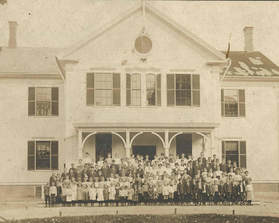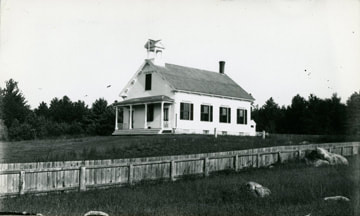|
8/30/2018 Maintenance Matters As students and teachers head back to school, it seems a good time to turn our attention back to Acton school history. Reading the School Committee’s annual reports can be eye-opening. Conditions and attitudes could be quite different from today’s. For example, the 1911 report (pages 7-9) revealed that a state inspector had ordered fire escapes for the South and West two-story schoolhouses in September, 1909, but nothing was done about it. In July, 1910, the next inspector repeated the order and additionally called for improved ventilation in the West and Center schoolhouses after “a chemical analysis of the air showed ‘bad contamination.’” To deal with air quality, the school committee had the heating systems repaired. However, “upon the request of the committee the state police did not press the matter of the construction of the fire escapes on the South and West schoolhouses and the matter has gone over until summer (of 1911).” The actual building of both fire escapes was finally noted to be complete in the January, 1913 report (page 22). Postponing investment in school buildings seems to have been a recurring theme. The 1891-92 annual report mentioned that the School Committee and the state inspector had disagreed before: “A contemplated heavy expense upon a change in our school structures for a more satisfactory ventilation, ordered by the State Inspector of Public Buildings, has been deferred for the present... the Board of Health finally decided to annul the order, leaving the whole subject for future deliberation and action.” (page 45) The School Committee suggested that the the issue of bad air in classrooms could be solved by using the “magnificent system of ventilation” available for free; teachers could simply open a window. The 1891-92 Committee was fighting an old battle. As far back as 1846-47, the School Committee reported on air and ventilation problems in the classrooms, especially in winter. To keep a reasonable temperature, the fire in the stove would be stoked, eventually raising the air temperature to uncomfortable levels. Then the upper sash of the windows would be lowered, and cold winter air would pour down on the students nearby. Soon the room would get too cold, the fire would be renewed, and the cycle would begin again. “Thus as though our climate were not changeable enough, the scholars are made to pass from summer to winter and winter to summer, twenty times a day.” (page 11) Stoves used up oxygen needed in crowded classrooms and produced pollutants. In an attempt to improve air quality, ventilators were installed on some of the schoolhouses by 1852, but both the 1851-52 and the 1861-62 reports mentioned that the needed (and relatively inexpensive) adjustable air-intake vents had been omitted, making the system less effective. (page 8 and 21) Air and temperature in the classrooms were not the only problems. In early days, of course, the schools had no running water and no indoor plumbing. The 1846-47 school report mentioned that every school house should be supplied with drinking vessels and, whenever possible, a good well of water. (page 12) Obtaining water was an ongoing issue. The 1911 report (page 9) mentioned that “We have been obliged to make some repairs upon the well at West Acton school and to dig an entirely new well at the South school to avoid sewage contamination.” In the January 1912 report, the school committee noted that “The problem of furnishing drinking water for the West and Center schools is still a perplexing one. There seems no other way at present than to hire it carried.” (page 10) This issue was resolved when town water was finally piped to the West and Center Schools. (Jan. 1913 report, page 22) A teacher’s January 6, 1913 entry in a diary held by the Society told us that “The water-pipe was laid through the pines to [the Center] schoolhouse cellar this vacation.” Water systems were installed in the Center and West schools that summer. However, “It was the opinion of the committeeman from South Acton that this expense was not necessary for the South school.” (Feb. 1914 report, page 7). Before the days of indoor plumbing and septic systems, the schools had to provide other accommodations for comfort and public health. In 1802 town meeting explicitly provided for building and painting “necesary houses” to accompany each schoolhouse. Deferral of costs may also have extended to outhouses, occasionally leading to unappealing recommendations in school reports. In 1881, the school committee emphasized “We consider it very important that the out-buildings of our school-houses shall be properly cleansed every spring.” (page 8) In 1892-93, the added suggestion was that: “the out-houses at the South and West should be provided with better means of ventilation, and those in the other districts be repaired.” (Page 58) Outhouses attracted graffiti. In 1881, the School Committee noted that the outhouses needed to be whitewashed so that “every mark which might make an injurious impression upon the minds of the young shall be obliterated.... Unless constant vigilance is used, in this direction, some of the objections which have been made to our system of common schools, on moral grounds, will prove to be well founded.” (page 8) At least the schools actually had outhouses at that point. In 1899, the town’s inaction had led to such acute crowding in the South Acton school that the town had to rent space in a building near the railway tracks fronting ”a public and much used business square, without grounds and consequently without proper sanitary arrangements.” (1903-04 report, page 12) In the 1920s, costs for indoor plumbing and “sewerage” systems started showing up in school reports, though there were still some problems. The new high school’s septic system did not work properly at first, necessitating more digging. (1927 report, page 24) In 1928, the “unwholesome odors and condition” of the South Acton School’s toilets were finally fixed after having been a problem for years. (page 18) “Flush closets” were voted for the Center and West schools in March, 1922, but the town did not appropriate enough money to complete the job. The Center School got them in 1925. For some reason, West Acton lagged behind the rest of the town. The 1926 report recommended “that toilets be installed in the West School to improve sanitary conditions,” (page 6) and an attempt at funding its “flush closets” was made at the March 1927 town meeting. Nothing was done. In the 1930 report, the School Committee finally reported being “able to install flush closets in the West Acton School. While some other repairs that seemed quite necessary were postponed the condition of the toilets at the West Acton School was such that all other repairs were put aside to meet the conditions there.” (page 5) One does not want to dwell too long on what those conditions were. As a final note, landscaping was another item that might or might not be in the town’s budget. In the 1846-47 report, the school committee suggested that the ground around the schoolhouses be banked up and smoothed “so that the little ones may get in at the doors without a ladder, and may play about the premises without risk of neck or limbs in tumbling over stones that do congregate there.” (Page 12) Playgrounds were urged so that students would not trespass on neighbors’ property. (1848-1849 report, page 5) Eighty years later, creating decent recreational space among Acton’s rocks, ledges, and roots was still a problem. Landscaping and the creation of decent athletic facilities around the new high school took years and substantially more money than anticipated. The original plan had been to blast the nearby ledge, but the cost was too great, so fill was brought in to cover it instead. The 1929 report noted that (page 18) “During the operation most of the huge stones that formerly lined the field were buried in the fill. A bit of the ledge was also removed, but the greater part still remains.” That was a problem left to a later School Committee. In every era, there are school maintenance and safety issues that need to be addressed. Reflecting on conditions in early years, we cannot help being grateful for those in each generation who have maintained Acton’s schools and worked for their improvement. Comments are closed.
|
Acton Historical Society
Discoveries, stories, and a few mysteries from our society's archives. CategoriesAll Acton Town History Arts Business & Industry Family History Items In Collection Military & Veteran Photographs Recreation & Clubs Schools |
Quick Links
|
Open Hours
Jenks Library:
Please contact us for an appointment or to ask your research questions. Hosmer House Museum: Open for special events. |
Contact
|
Copyright © 2024 Acton Historical Society, All Rights Reserved

 RSS Feed
RSS Feed